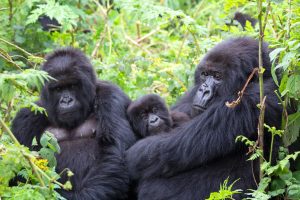Forest Walks in Kibale National Park
Forest Walks in Kibale National Park, nestled in the lush landscapes of western Uganda, is a biodiversity haven, particularly famous for its rich primate population. While chimpanzee trekking often steals the spotlight, the park offers a variety of experiences that make it a must-visit for nature lovers. One such activity is the forest walk, which provides a tranquil yet immersive way to explore the park’s dense tropical forest, teeming with wildlife, birds, and unique flora.
Whether you’re a solo traveler, part of a group, or on a family adventure, a forest walk in Kibale National Park promises a peaceful connection with nature, far from the usual hustle of everyday life.
1. Why Choose a Forest Walk in Kibale?
While Kibale is famous for its primates, including chimpanzees, the forest walks provide a deeper experience of the park’s incredible biodiversity. Here are some reasons to add a forest walk to your itinerary:
- Explore Beyond Primates: While chimpanzee trekking is focused on primate sightings, a forest walk opens up opportunities to discover a broader range of wildlife, such as forest elephants, bushbucks, and various monkey species.
- Birdwatcher’s Paradise: Kibale is home to over 375 bird species, and a quiet walk allows you to spot some of the park’s rarest birds, including the African pitta, green-breasted pitta, and great blue turaco.
- Botanical Diversity: The dense forest is rich with towering trees, exotic plants, ferns, and fungi. It’s a chance to learn about medicinal plants used by local communities and see magnificent old-growth trees.
- Tranquility and Connection: Away from the noise and excitement of tracking large animals, the forest walk offers peace, serenity, and the chance to connect deeply with nature’s rhythms.
2. What to Expect on a Forest Walk
Kibale’s forest walks are led by knowledgeable, local guides who bring the forest to life with their expertise. The walks typically last from 2 to 3 hours, with several trails to choose from depending on your fitness level and interests.
- Trail Conditions: The trails vary in difficulty, ranging from relatively easy walks to more strenuous hikes. Expect some uneven terrain, mud, and occasional steep inclines, but the walks are generally manageable for people of most fitness levels.
- Wildlife Sightings: While not as intense as a safari, a forest walk can still offer memorable wildlife encounters. You may spot forest elephants, red and blue duikers, or several species of primates like the L’Hoest’s monkey or red-tailed monkey.
- Birdwatching Opportunities: If you’re a birder, bring a pair of binoculars. The forest is alive with birdsong, and your guide will help identify different species, offering the chance to spot some rare and endemic birds.
3. Best Trails for Forest Walks in Kibale
The park has several well-maintained trails, each offering something unique:
- Kanyanchu Primate Walk: This trail is known for its proximity to primate habitats and offers an excellent chance to see different monkey species, along with potential chimpanzee sightings.
- Sebitoli Area: Located in the northern part of Kibale, this area is less visited than Kanyanchu and provides a quieter, more remote forest walk experience. It’s particularly rich in birdlife and offers great photography opportunities.
- Bigodi Wetland Sanctuary: Located near the edge of the park, this trail offers a mix of forest and wetland ecosystems. It’s perfect for birdwatching and spotting smaller wildlife, such as otters, bushbucks, and butterflies.
4. What to Bring on Your Forest Walk
To fully enjoy your forest walk in Kibale National Park, it’s essential to be well-prepared. Here’s a list of items you should consider packing:
- Comfortable Hiking Shoes: The trails can be muddy and slippery, so sturdy, waterproof shoes with a good grip are a must.
- Insect Repellent: Kibale’s forest is home to insects, particularly mosquitoes, so protect yourself by applying repellent.
- Waterproof Clothing or Poncho: The park’s climate is humid, and rain can fall unexpectedly, so pack lightweight, waterproof layers.
- Binoculars and Camera: A forest walk offers great birdwatching and wildlife photography opportunities. A camera with a zoom lens and a pair of binoculars will enhance your experience.
- Reusable Water Bottle: Staying hydrated is key, especially in the humid conditions of the forest. Carry a reusable water bottle to minimize plastic waste.
5. Forest Walk Etiquette
As with all nature-based activities, it’s essential to be respectful of the environment to ensure that your experience leaves no negative impact on the ecosystem.
- Keep Noise to a Minimum: Wildlife is naturally shy and may avoid noisy groups. Keeping quiet increases your chances of seeing animals and hearing the natural sounds of the forest.
- Stick to Designated Trails: The park’s trails are designed to minimize damage to sensitive areas. Follow your guide and stay on the paths to help preserve the forest.
- Do Not Feed or Disturb Animals: As tempting as it might be to interact with the animals you encounter, it’s essential to let them remain wild. Feeding them can disrupt their natural behavior and diet.
6. Best Time for Forest Walks in Kibale
The best time to go on a forest walk in Kibale National Park is during the dry seasons, from December to February and June to September. The trails are less muddy, and it’s easier to spot wildlife congregating around water sources. However, Kibale can be visited year-round, and the wet season (March to May, October to November) brings lush vegetation and fantastic birdwatching opportunities.
7. Combining Forest Walks with Other Activities
A forest walk in Kibale is just one part of a larger adventure. Here are some other activities to consider adding to your itinerary:
- Chimpanzee Trekking: Kibale’s most famous activity, offering a close encounter with our closest relatives in their natural habitat.
- Bigodi Wetland Sanctuary Walk: A guided tour through this community-run reserve, which supports sustainable tourism and conservation efforts.
- Cultural Encounters: Visit local communities to learn about the traditional ways of life, including basket weaving and coffee farming.
8. Sustainable Tourism in Kibale National Park
Forest walks in Kibale are not only enjoyable but also contribute to sustainable tourism efforts. By taking part in these guided walks, you’re supporting conservation initiatives and local communities. The Uganda Wildlife Authority (UWA) and local organizations work together to ensure that tourism in Kibale remains environmentally responsible, helping protect the park’s fragile ecosystems for future generations.
Conclusion
forest walks in Kibale National Park is more than just a leisurely hike—it’s an intimate exploration of one of Africa’s richest rainforests. Whether you’re a nature enthusiast, a birdwatcher, or just someone looking to reconnect with the natural world, the forest walk offers an opportunity to immerse yourself in the sights, sounds, and beauty of Uganda’s wilderness. Combine it with other park activities for a well-rounded experience that you’ll cherish for a lifetime.




